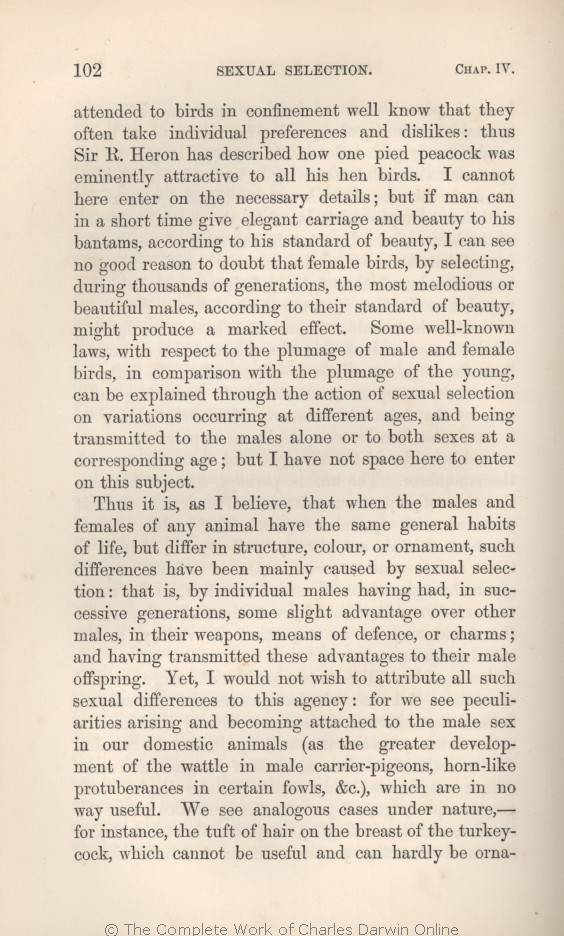attended to birds in confinement well know that they often take individual preferences and
dislikes: | dislikes: 1859 1860 1861 1866 1869 | | dislikes; 1872 |
| one 1859 1860 1861 1866 1869 | | a 1872 |
| I 1869 1872 |
| It may appear childish to attribute any effect to such apparently weak means: I 1859 1860 1861 1866 |
| ..... 1869 1872 | | details 1859 1860 1861 1866 |
| details; 1869 1872 |
| to support this view; 1859 1860 1861 1866 |
| elegant carriage and beauty 1859 1860 1861 1866 1869 |
| beauty and an elegant carriage 1872 |
| OMIT 1869 1872 |
| I strongly suspect that 1859 1860 1861 1866 |
| Some 1869 1872 | | some 1859 1860 1861 1866 |
| laws, 1860 1861 1866 1869 1872 | | laws 1859 |
| be explained through the action of 1869 |
| be explained on the view of plumage having been chiefly modified by 1859 1860 1861 1866 |
| partly be explained through the action of 1872 |
| selection 1869 1872 | | selection, 1859 1860 1861 1866 |
| 1 blocks not present in 1869 1872; present in 1859 1860 1861 1866 | | acting when the birds have come to the breeding age or during the breeding season; the modifications thus produced being inherited at corresponding ages or seasons, either by the males alone, or by the males and females; but I have not space here to enter on this subject.
|
|
Thus it is, as I believe, that when the males and females of any animal have the same general habits of life, but differ in structure, colour, or ornament, such differences have been mainly caused by sexual
selection: | selection: 1869 1872 | | selection; 1859 1860 1861 | | selec- tion; 1866 |
| by individual males having 1869 1872 |
| individual males have 1859 1860 1861 1866 |
| charms; 1859 1860 1861 1866 1869 | | charms, 1872 |
| and 1859 1860 1861 1866 1869 | | which they 1872 |
| having 1869 | | have 1859 1860 1861 1866 1872 |
| these advantages 1859 1860 1861 1866 1869 | these advantages 1872 |
| offspring. 1859 1860 1861 1869 | | off-spring. 1866 | | offspring alone. 1872 |
| such 1859 1860 1861 1866 1869 | such 1872 |
| peculiarities 1859 1860 1861 1866 1869 |
| in our domestic animals peculiarities 1872 |
| sex 1859 1860 1861 1866 1869 | | sex, 1872 |
| in our domestic animals (as the greater development of the wattle in male carrier-pigeons, horn-like protuberances in certain fowls, &c.), which are in no way useful. 1869 |
| in our domestic animals (as the wattle in male carriers, horn-like protuberances in the cocks of certain fowls, &c.), which we cannot believe to be either useful to the males in battle, or attractive to the females. 1859 1860 1861 1866 |
| which apparently have not been augmented through selection by man. 1872 |
| nature,— 1866 1869 | | nature, 1859 1860 1861 |
| cannot be useful and can 1869 |
| can 1859 1860 1861 1866 |
| orna- mental;— 1869 |
| either useful or ornamental to this bird;— 1859 1860 1861 1866 |
|









